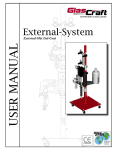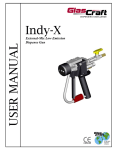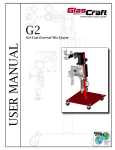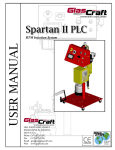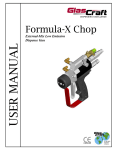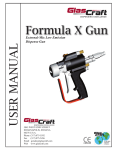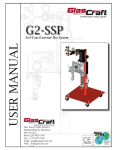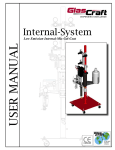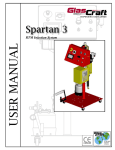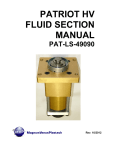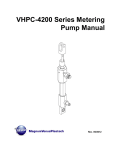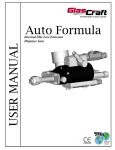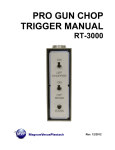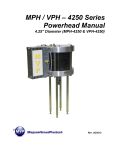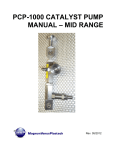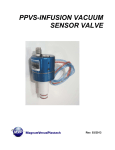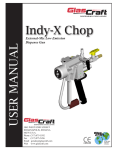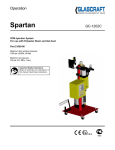Download Spartan System User Manual
Transcript
USER MANUAL Spartan RTM Injection System Table Of Contents Section 1 Installation 1:1 Introduction ........................................................................................................................................................ 1:2 Standard Equipment .......................................................................................................................................... 1:3 Specifications ..................................................................................................................................................... 1:4 Equipment Assembly .......................................................................................................................................... 1 2 N/A 3 Section 2 Operation 2:1 Start-up Instructions .......................................................................................................................................... 2:2 Shut–down Instructions ..................................................................................................................................... 6 11 Section 3 General Information 3:1 Assembly Drawings ........................................................................................................................................... 3:2 Sub-Assembly Drawings ................................................................................................................................... 3:3 Maintenance ...................................................................................................................................................... 3:4 Troubleshooting ................................................................................................................................................. 3:5 Options .............................................................................................................................................................. 12 18 25 26 N/A Section 4 Safety Information 4:1 General Safety .................................................................................................................................................. 4:2 Notes ................................................................................................................................................................. 4:3 Limited Warranty Policy ..................................................................................................................................... 4:4 Technical Assistance ......................................................................................................................................... 27 35 39 40 For Your Reference .................................................................................................................. INSIDE BACK COVER N/A= Not Applicable Introduction Before operating, maintaining or servicing any GlasCraft system, read and understand all of the technical and safety literature provided with GlasCraft products. If you do not have the proper or related manuals and safety literature for your GlasCraft system, contact your GlasCraft distributor or GlasCraft,Inc. In this GlasCraft technical and safety publication, the following advisories will be provided where appropriate: The information in this document is intended only to indicate the components and their normal working relationship typical use. Each assembly should be directed by a GlasCraft distributor or made from the GlasCraft Assembly instructions provided. This manual provides information for the assembly, operation, maintenance and service of this GlasCraft product as used ina typical configuration. While it lists standard specifications and procedures, some deviations may be found. Is information about the procedure in progress. In order to provide our users with the most up-to-date technology possible, we are constantly seeking to improve products. If technological change occurs after a product is on the market, we will implement that technology in future production and, if practical, make it available to current users as a retrofit, up-date or supplement. If you find some discrepancy between your unit and the available documentation, contact your GlasCraft distributor to resolve the difference. GlasCraft, Inc. reserves the right to change or modify this product as it deems necessary. Is imperative information about equipment protection. CAUTION Indicates a hazardous situation which, if not avoided, could result in minor or moderate injury. WARNING Careful study and continued use of this manual will provide a better understanding of the equipment and process, resulting in more efficient operation, longer trouble-free service and faster, easier troubleshooting. Indicates a hazardous situation which, if not avoided, could result in death or serious injury. ELECTRICAL SHOCK HAZARD Indicates a hazardous situation which, if not avoided, could result in electrical shock or serious injury. Sec1:1 Section 1- Installation: Introduction Sec1:2 Section 1- Installation: Standard Equipment Spartan System Standard Equipment Part Number Description 20864-07 MATERIAL PUMP ASSEMBLY, 13:1 RATIO SSP-160-01 SUPER CATALYST SLAVE PUMP ASSEMBLY 21661-00 AIR LOGIC ASSEMBLY 20941-00 CATALYST BOTTLE ASSEMBLY LPA-169 CATALYST BOTTLE BRACKET ASSEMBLY 18291-01 / 20569-01 BASE & MAST 21654-00 SOLVENT TANK ASSEMBLY GAM-268-01 MATERIAL PUMP PICK-UP KIT 21694-25 MATERIAL HOSE ASSEMBLY, 25 FT. 20195-30 MATERIAL RECIRCULATION HOSE 17440-00 GROUNDING CLAMP ASSEMBLY 20190-30 CATALYST HOSE 30 FT. 20945-00 CATALYST RECIRCULATION HOSE 21054-01 SOLVENT HOSE 38 FT. 21668-00 GUN ASSEMBLY GC-1202 MANUAL 4. Securely attach Clamp, P/N 7749-00 to permanently The Spartan comes complete and fitted with all resin hoses, catalyst bottle and filters. The injection head is fully connected to the machine circuit and tested and secured against leaks prior to dispatch. grounded rod or pipe. The following instructions are to be used as a guide for consistent and continual operation. Any deviation from the “standard operation”, usually requires more maintenance to the equipment and material formulation to assure consistent results. For example: the use of fillers in resins. 1. Select a clean, dry air supply. 2. Attach a 3/8” or larger air hose to the Air Inlet on the yellow air lock-out valve. CAUTION Whenever flammable or combustible liquids are transfered from one container to another, both containers shall be effectively bonded and grounded to dissipate static electricity. For further information see..... NFPA 77,Recommended Practice on Static Electricity. 5. Remove the pump inlet saftey cap and drain the It is suggested that a quick disconnect fitting not be used for attaching air. Quick disconnect fittings can severely limit air flow. testing oil into an open container. 6. Attach 4 casters with provided lock washer, washer and nut. Attach solvent tank support rod on back left caster. CAUTION Before turning on main air, check all fittings, making certain they are securely tightened. This should be done before air or material of any kind is introduced into the system. 3. Attach Grounding Clamp Assembly, P/N 17440-00, to System. Use a convenient Nut and Bolt to secure Lug, P/N 13193-00, to system. 7. Attach solvent tank to solvent tank support rod with provided rubber strap. Sec1:4 Section 1 - Installation: Equipment Assembly Sec1:4 Section 1- Installation: Equipment Assembly 8. Attach the catalyst jug bracket to the mast. 9. Attach the green material hose to the pick-up tube and insert the tube into a bucket of clean solvent. Recirculation hose from the gun. SOLVENT CONTAINER 10. Attach the green material hose to the material pump. SOLVENT/WASTE CONTAINER 11. Insert the end of the recirculation hose into a waste container. Section 1 - Installation: Equipment Assembly Sec1:4 12. Make sure solvent regulator is dialed to zero. (Turn knob fully counter-clockwise) 17. Replace yellow guard using a 5/32” hex balldriver. 13. Carefully relieve any pressure in the solvent tank by slowly pulling the relief valve. 14. After all the pressure is released from the tank, open the lid and fill the tank with a suitible, clean flushing solvent and close the lid securely. 18. Before operating the material pump, flush thoroughly with a clean, suitible solvent to remove test fluid. 15. Remove yellow guard using a 5/32” hex balldriver. GlasCraft uses test fluid that may not be compatible with some resins. It is recommended that the test fluid be flushed from the material pump fluid section. Make sure hose fittings on the pick-up hoses are tight. 19. Safely fill the Catalyst Supply Bottle, P/N LPA-165, (maximum two gallons) with preferred MEKP catalyst, to a minimum level of at least two inches above the Catalyst Bottle Outlet Fitting. WARNING Remove Catalyst Bottle, P/N 20941-00 from Catalyst Bottle bracket, P/N LPA-169 for filling. Bottle should be placed at or below lowest level for safe filling. Never fill Catalyst bottle while mounted in bracket as personal injury from catalyst spillage could result 16. Fill material pump lube cup with proper pump lube. Section 2 - Operation: Start-up Instructions Sec2:1 Start-up Instructions The following instructions are to be used as a guide for consistent and continual operation. Any deviation from the “ standard operation”, usually requires more maintenance to the equipment and material formulation to assure consistent results. For example: the use of fillers in resins. Solvent 3-way valve Before initial operation of any internal mix system, make certain the solvent flush set-up is fully operational. 1. Turn solvent regulator clockwise to approximately 65 psi. 3. Exhaust air through the gun head until traces of solvent have been dissipated. 2. Place injection nozzle over a proper waste container. Since the system is an internal mix system, the mixer requires flushing with air-solvent-air after each dispense or before the mixed material starts to gel. Turn 3-way valve on top of the solvent tank so the arrow is pointing up for air purge, for solvent turn the valve so the arrow is pointing down. Repeat air purge to blow solvent through the gun head. Section 2 - Operation: Start-up Instructions 5. Turn the material injection regulator slowly clockwise Resin until gauge indicates 10 PSI or until pump cycles slowly. 1. Detach the catalyst slave pump from the material pump. Sec2:1 Pull and rotate knob to disengage the catalyst drive arm. Knob 6. Pump should cycle clean solvent through the system and out the recirculation hose. 2. Turn main valve on the gun head to the recirculation 7. End recirculation when solvent appears reasonably position. clean. “OFF” ← → RECIRCULATION ON OFF 3. Turn the material air regulator fully counter-clockwise. 8. Remove material pump pick-up tube from solvent container and dry thoroughly. 9. Switch machine recirculation to “ON”. ← ← RECIRCULATION ON OFF 4. Switch machine recirculation to “ON”. ← RECIRCULATION ON OFF Section 2 - Operation: Start-up Instructions 10. When solvent has stopped exiting the recirculation hose, end recirculation. (OFF) RECIRCULATION ON OFF → Sec2:1 → 11. Place material pump pick-up tube in desired con- tainer of material while keeping recirculation return hose in a waste container. Make sure all the air is purged out of the catalyst pump on new start up. 12. Turn machine to recirculation. (ON) ← 2a. Pull and rotate Pivot knob to disengage the catalyst drive arm. RECIRCULATION ON OFF 13. Let material pump cycle slowly until a steady b. Turn the slave pump yellow ball valve to the open position. stream of clean material is seen exiting the recirculation hose. 14. Switch machine recirculation to “OFF”. c. Hand prime the pump until a steady stream of catalyst flows back to the bottle. → d. Close the ball valve. Hand stroke the pump until it developes 50-60 PSI. RECIRCULATION ON OFF 15. Secure recirculation hose in the material supply 3. Set the slave pump to 3.5 percent. container. It is usually a general practice when starting up the system to let the system recirculate with the Catalyst Slave Pump set at 3.5%. This ensures good catalyst volume movement through the system to remove air in the catalyst system. Dispose of resin in the waste container in a proper manner. Catalyst 1. Turn Catalyst Valve on the dispense gun to recirculation position (arrow on valve should point away from gun block). Section 2 - Operation: Start-up Instructions 4. Re-engage the catalyst pivot knob. Make sure that the knob engages inside the catalyst drive arm slot. Failure to do so will cause damage to the catalyst drive arm Recirculation Mode (Start-Up) 1. Both Catalyst Valve and Material Valve on the Dispense Gun should be in the Recirculation position. Sec2:1 → The Recirculation Mode should be used in initial start-up or when air bubbles are observed coming through the ends of the Recirculation Hoses. Injection Instructions 1. Switch machine to injection. (set recirculation to off) ← → RECIRCULATION ON OFF 2. Turn valves on gun head to injection. → → 2. Switch machine recirculation to “ON”. ↑ ← RECIRCULATION ON OFF 3. Turn air motor pressure regulator slowly clockwise until pump cycles slowly. Section 2 - Operation: Start-up Instructions CAUTION The valves should only be in the injection position during injection Sec2:1 → 3. Select desired percentage of catalyst and position the catalyst slave pump to that setting. CAUTION 4. Depress air switch button trigger on gun head to dispense mixed material. When making test material dispenses or during flushing operation, make certain that dispensed material and/or solvent is contained in a suitable container and that this material and/or solvent is disposed of properly. 7. Flush gun head thoroughly. Turn 3-way valve on top of the solvent tank so the arrow is pointing up for air purge, for solvent turn the valve so the arrow is pointing down. PRESS When starting the machine, it is recommended to dispense a couple of strokes of resin into a suitable container to ensure a proper flow of materials. Also, test for proper gel and cure times. 5. Release air switch button trigger to stop material flow. 3-way valve 6. When finished, turn valves on gun head to recirculation position. ← 10 Section 2 - Operation: Shut Down Instructions Shut Down Procedure 5. Material pump should now be cycled so that shaft is left in down position during shut-down period. Sec2:2 The purpose of the shut down procedure is to verify that all critical parts of the system, i.e., the mixing area, have been checked and cleaned to assure trouble-free start-up the next time the system is to be operated. 1. Turn both ball valves on gun head to “OFF”. (90˚) ↑ 6. If you are using fillers mixed into the resin, remem- ber on periods of shut-down, the fillers can settle to the bottom of the pump and pipe-works. 7. Shut down main air supply by closing yellow lock out valve. If using a filled resin it is suggested that the material pump and hoses be flushed with a “neat” resin and that the neat resin is flowing through the system and exiting the material recirculation hose thoroughly before shut down procedures are completed. ↑ 2. Flush gun head with solvent and air purge thoroughly. 3. Material pump should be stopped with pump shaft in up position and shaft should be cleaned of any contaminants. 8. Slowly bleed the air pressure from the tank by lifting the ring on the relief valve. 4. Material pump lube cup should be cleaned of old lube and refilled with new pump lube. 11 Failure to cycle Pump Shaft to DOWN position may result in contaminants to dry or harden on shaft. When pump is next operated, severe damage may be done to upper pump seals. Section 3 - General Information: Assembly Drawings Sec3:1 21650-00 Unit Assembly 12 REVISION W ** 13 ** For a detailed view, see GC-1303 * For a detailed view, see GC-1337 * * Sec3:1 20735-07 Section 3 - General Information: Assembly Drawings 21650-00 Unit Assembly REVISION W Section 3 - General Information: Assembly Drawings Sec3:1 21650-00 Unit Assembly 14 REVISION W Section 3 - General Information: Assembly Drawings Sec3:1 21650-00 Assembly Hose Connections 15 REVISION W Section 3 - General Information: Assembly Drawings 21650-00 Gun Hoses * * Part numbers 20732-01 and 21054-01 go inside of 9704-09. Sec3:1 * * 16 REVISION W Section 3 - General Information: Assembly Drawings Part Number Description Qty. Part Number Description Qty. 13424-01 CABLE TIE 3 7733-12 NUT 2 17440-00 GROUNDING CLAMP 1 7733-14 NUT 2 18199-02 AIR REGULATOR 1 7733-42 NUT 4 18291-01 FLOOR MOUNT BASE 1 7734-06 WASHER 15 18318-02 AIR GAUGE 1 7734-07 WASHER 6 19845-00 FRP LITERATURE 1 7734-10 WASHER 8 19882-00 MAST CAP 1 7957-32F SCREW 2 19889-00 MOUNTING ADAPTER 2 7958-56C SCREW 2 19891-00 PIPE CLAMP 4 8155-160C SCREW 4 19892-00 COVER PLATE 3 9672-11 FITTING 1 20188-16C SCREW 17 9704-09 NATURAL TUBING 25’ 20190-30 CATALYST HOSE 2 9704-11 NATURAL TUBING 9’ 20195-30 RECIRCULATION MATERIAL HOSE 1 9955-24C SCREW 4 20368-00 CASTER 4 CP-126 U-BOLT 2 20569-01 SUPPORT MAST 1 G-403 STRAP 1 20655-04 FITTING 1 GAM-268-01 PICK-UP TUBE 1 20731-04 BLUE TUBING 7’ GC-1202 USER MANUAL 1 20732-01 RED TUBING 32’ LPA-169 BOTTLE SUPPORT ASSEMBLY 1 20732-02 YELLOW TUBING 1.166’ SSP-157-01 DECAL 1 20735-07 ELBOW FITTING 1 SSP-160-01 SLAVE PUMP ASSEMBLY 1 20864-07 MATERIAL PUMP ASSEMBLY 1 SSP-172 GUARD 1 20941-00 CATALYST JUG 1 SSP-173 GUARD 1 20945-00 RECIRCULATION ASSEMBLY 1 SSP-174 BRACKET 1 21054-01 NYLON TUBING 38’ SSP-176 GUARD WINDOW 1 21654-00 SOLVENT TANK 1 SSP-177 GUARD 1 21661-00 AIR LOGIC ASSEMBLY 1 SSP-178 GUARD 1 21663-00 MOUNTING BLOCK 1 21668-00 SPARTAN GUN 1 21670-00 TANK SUPPORT 1 21674-00 HOSE GUIDE 1 21694-25 MATERIAL HOSE ASSEMBLY 1 3923-02 SPIRAL WRAP 28’ 7486-04 WASHER 4 7486-05 WASHER 16 7486-07 WASHER 4 7486-13 WASHER 3 17 REVISION W Sec3:1 21650-00 Assembly Parts List Section 3 - General Information: Sub-Assembly Drawings Sec3:2 21661-00 Air Logic Assembly 18 REVISION P Section 3 - General Information: Sub-Assembly Drawings Sec3:2 21661-00 Air Logic Connections TO SOLVENT TANK TO AIR MOTOR TO GUN AIR TRIGGER 19 REVISION P 23547-01 Check Valve Assembly * * Mixing nozzle part number 20625-00 is included with 21662-00 ** 22909-00 is not included with 23547-01 Sec3:2 Section 3 - General Information: Sub-Assembly Drawings 21668-00 Spartan Gun Assembly 20 REVISION E Section 3 - General Information: Sub-Assembly Drawings Part Number Description Qty. 15902-00 FITTING 1 19881-00 PLUG 1 20306-00 FITTING 1 20735-04 FITTING 1 20810-00 BALL VALVE 1 20878-00 VALVE 1 20879-00 PUSH BUTTON 1 21044-02 O-RING 1 21454-00 BRACKET 1 21465-32C STUD 2 21535-00 CHECK VALVE 1 21652-00 NOZZLE 1 21656-00 BLOCK 2 21662-00 INJECTION WAND 1 21664-00 CHECK VALVE 1 21665-00 HANDLE 2 21667-00 BALL VALVE 1 21675-00 CHECK VALVE 2 21676-00 WASHER 2 22904-00 VALVE STEM 1 22906-00 WASHER 1 22908-00 NUT 1 22909-00 VALVE BODY 1 23524-01 SPRING 1 23540-00 VALVE BODY 1 7597-04 FITTING 1 7734-04 WASHER 2 7966-17 FITTING 1 8114-03 FITTING 1 8212-16C SCREW 2 8560-03 FITTING 1 8560-22 FITTING 1 RM-856-04 FITTING 1 21 Sec3:2 21668-00 Spartan Gun Parts List REVISION E Section 3 - General Information: Sub-Assembly Drawings Sec3:2 GAM-268-01 Material Pick-Up Kit Part Number Description Qty. 20394-00 PICK-UP TUBE 1 20395-00 ELBOW FITTING 1 20397-01 30 MESH FILTER 1 20398-02 MATERIAL HOSE 1 Filter Options 22 Part Number Description 20397-02 100 MESH 20397-03 50 MESH REVISION D Section 3 - General Information: Sub-Assembly Drawings 20941-00 Catalyst Bottle Assembly Sec3:2 20945-00 * * Shown for connection purposes only. Not included with 20941-00 assembly. 23 Part Number Description LPA-172 BOTTLE SUPPLY FILTER 1 20390-00 FITTING 1 20934-00 JUG CAP 1 20939-00 MALE CONNECTOR 2 20940-00 SUPPLY BOTTLE 1 21039-00 FITTING 1 21040-00 ELBOW FITTING 1 21045-01 HEX NUT 1 9704-11 NATURAL TUBING 5’ Qty. REVISION G Section 3 - General Information: Sub-Assembly Drawings Sec3:2 21654-00 Solvent Tank Assembly Part Number Description Qty. ISD-141-3 MINI REGULATOR 1 ISD-142 SOLVENT POT GAUGE 1 11021-23 PIPE PLUG 1 20263-00 VALVE 1 20324-00 SOLVENT TANK 1 20365-00 VALVE 1 20655-02 ELBOW FITTING 1 20720-00 VALVE 1 20798-02 FITTING 1 21669-00 CHECK VALVE 1 4342-01 ELBOW FITTING 1 7596-01 FITTING 1 7892-01 FITTING 1 8115-01 FITTING 1 24 REVISION D Section 3 - General Information: Maintenance Maintenance It is recommended that the following service be performed on a weekly basis. 1. Inspect and lubricate Catalyst Slave Pump Linkage. (See Catalyst Slave Pump User Manual.) making certain they are clean and free of overspray or foreign material. Clean and lubricate as required. For long term storage of your injection system, it is recommended that the following procedures be followed. 1. Place dry nitrogen in the material drums and secure drum. 2. Make certain all air and material valves are in their “OFF” position. GlasCraft recommends that you contact your gel-coat and/or resin supplier concerning material pot-life during extended periods of shut-down. The decision as to whether or not to leave material in your system should be based on information from your material suppliers as well as GlasCraft. Consult your local authorized GlasCraft distributor for more information concerning system storage. 25 Sec3:3 2. Inspect Pump Shafts on Material and Catalyst Pumps, Section 3 - General Information: Troubleshooting Troubleshooting Sec3:4 Before altering catalyst percentage by moving the catalyst pump to a new desired location on the ratio arm ALWAYS ensure that the catalyst recirculation valve is turned to the recirculation position, and the air pressure is removed from the system. It is absolutely essential that both streams of material are pumped to the head without air or gas entrapped. For example, if air is drawn into the resin stream through the resin pump inlet system, i.e., via bad connection or filter end coming out of resin surface, then this air if not purged out of the machine by recirculating on by-pass will naturally go to the head through the mixer and into the RTM mold. This fault condition will manifest itself in the molded part having very small bubbles; almost in a froth like state, on the upper side of the molded part once the mold is opened. The reason for these bubbles being so small is due to the fact that air coming through the mixer with the resin is mixed and frothed before finally entering the mold. Air or gas in the catalyst stream, leads to a different type of fault in the molded part. This condition will be manifest by observing when opening the mold after injec tion and supposed cure, that there are wet patches of uncured or semi-gelled resin in the molded part. The causes attributed to this are: 1. Air is drawn in by the catalyst pump through a bad connection on the inlet stream from the catalyst container or pump inlet connection. 2. Catalyst contamination in the pump system causing oxidation resulting in peroxide gas bubbles being generated within the supposedly hydraulic sealed system of the catalyst. 3. The catalyst pump has faulty seals or is contaminated with particles. To ensure that the catalyst system is totally hydraulically tight, it is expedient after a period of shut-down that the procedures in the instructions for commissioning the catalyst stream should be repeated. 26 Section 4 - Safety Information: General Safety Operating Your Polyester System Safely particularly Paragraph (m) Organic Peroxides and Dual Component Coatings. Other standards and recognized authorities to consult are the National Fire Protection Association (NFPA) bulletins as follows: 1.0 Introduction Any tool, if used improperly, can be dangerous. Safety is ultimately the responsibility of those using the tool. In like manner, safe operation of polyester processes is the responsibility of those who use such processes and those who operate the equipment. This manual outlines procedures to be followed in conducting polyester operations safely. This system has been specifically designed for use of Polyester Resin ,Gel-Coat ,and Methyl Ethyl Ketone Peroxides (MEKP) applications. Other formulations or blends considered for use in this equipment is strictly prohibited without the expressed consent by GlasCraft Inc. Fire Extinguisher -- code ABC ,rating number 4a60bc. Extinguishing Media -- Foam, Carbon Dioxide, Dry Chemical, Water Fog. GlasCraft, Inc. cannot eliminate every danger nor foresee every circumstance that might cause an injury during equipment operation. Some risks, such as the high pressure liquid stream that exits the spray tip, are inherent to the nature of the machine operation and are necessary to the process in order to manufacture the end-product. For this reason, ALL personnel involved in polyester operations should read and understand the Safety Manual. It is very important for the safety of employees involved in the operation that equipment operators, maintenance and supervisory personnel understand the requirements for safe operation. Copies of the above bulletins are available, at a nominal charge from: Research Report No. 11 of the American Insurance Association deals with “Fire, Explosion and Health Hazards of Organic Peroxides”. It is published by... Each user should examine his own operation, develop his own safety program and be assured that his equipment operators follow correct procedures. GlasCraft hopes that this manual is helpful to the American Insurance Association 85 John Street New York, New York 10038 Local codes and authorities also have standards to be followed in the operation of your spraying equipment. Your insurance carrier will be helpful in answering questions that arise in your development of safe procedures. user and recommends that the precautions in this manual be included in any such program. GlasCraft recommends this Safety Manual remain on your equipment at all times for your personnel safety. 1.2 Personnel Safety Equipment In addition to the manual, GlasCraft recommends that the user consult the regulations established under the Occupational Safety & Health Act (OSHA), particularly the following sections: • • • National Fire Protection Association 470 Atlantic Avenue Boston, MA 02210 GlasCraft recommends the following Personal Safety Equipment for conducting safe operations of the Polyester Systems: 1910.94 Pertaining to ventilation. 1910.106 Pertaining to flammable liquids. 1910.107 Pertaining to spray finishing operations, 27 Sec4:1 • NFPA No. 33 Chapter 14, Organic Perox ides and Dual Component Materials • NFPA No. 63 Dust Explosion Prevention • NFPA No. 70 National Electrical Code • NFPA No. 77 Static Electricity • NFPA No. 91 Blower and Exhaust System • NFPA No. 654 Plastics Industry Dust Hazards • Type of Fire Extinguishing equipment recommended : Section 4 - Safety Information: General Safety GlasCraft recommends that the user consult the state and local regulations established for all Safety equipment listed. 2.0Material Safety 2.1 Hazards Associated with Laminating Operations The major hazards which should be guarded against in polyester laminating operations are those associated with: Sec4:1 1. The flammability and explosion dangers of the catalyst normally used - Methyl Ethyl Ketone Peroxide (MEKP). 2. The flammability dangers of clean-up solvents sometimes used (GlasCraft recommends that clean-up solvents be nonflammable), and of resin diluents used, such as styrene. storage or use.Even a small amount of contamination with acetone, for instance, may produce an extremely shock-sensitive and explosive compound. Contamination with promoters, or materials containing promoters, such as laminate sandings, or with any readily oxidizable material, such as brass or iron, will cause exothermic “redox” reactions which can become explosive in nature. Heat applied to MEKP, or heat build-up from contamination reactions can cause it to reach what is called its Self-Accelerating Decomposition Temperature (SADT). Researchers have reported measuring pressure ratesof-rise well in excess of 100,000 psi per second when certain MEKP’s reach their SADT. (For comparison, the highest pressure rate-of-rise listed in NFPA Bulletin No. 68, “Explosion Venting”, is 12,000 psi per second for an explosion of 12% acetylene and air. The maximum value listed for a hydrogen explosion is 10,000 psi per second.) 3. The flammability dangers of catalyst diluents, if used. (GlasCraft recommends that catalyst not be diluted.) 4. The flammability dangers of the uncured liquid resins used. 5. The combustibility dangers of the cured laminate, accumulations of overspray, and laminate sandings. Some forms of MEKP, if allowed to reach their SADT, will burst even an open topped container. This suggests that it is not possible to design a relief valve to vent this order of magnitude of pressure rate-of-rise. The user should be aware that any closed container, be it a pressure vessel, surge chamber, or pressure accumulator, could explode under certain conditions. There is no engineering substitute for care by the user in handling organic peroxide catalysts. 6. The toxicity dangers of all the chemicals used in laminating operations with respect to ingestion, inhalation and skin and eye hazards. 2.2 MEKP is not a single chemical. Various polymeric forms may exist which are more or less hazardous with respect to each other. These differences may arise not only from different molecular structures (all are, nevertheless, called “MEKP”) and from possible trace impurities left from the manufacture of the chemicals, but may also arise by contamination of the MEKP with other materials in its Catalyst (Methyl Ethyl Ketone Peroxide) MEKP is among the more hazardous materials found in commercial channels. The safe handling of the “unstable (reactive)” chemicals presents a definite challenge to the plastics industry. the highly reactive property which makes MEKP valuable to the plastics industry in producing the curing reaction of polyester resins also produces the hazards which require great care and caution in its storage, transportation, handling, processing and disposal. 28 If, at any time, the pressure relieve valve on top of the catalyst tank should vent, the area should be evacuated at once and the fire department called. The venting could be the first indication of a heat, and therefore, pressure build-up that could eventually lead to an explosion. Moreover, if a catalyst tank is sufficiently full when the pressure relief valve vents, some catalyst may spray out, which could cause eye injury. For this reason, and many others, anyone whose job puts them in an area where this vented spray might go, should always wear full eye protection even when laminating operations are not taking place. Section 4 - Safety Information: General Safety Safety in handling MEKP depends to a great extent on employee education, proper safety instructions and safe use of the chemicals and equipment. Workers should be thoroughly informed of the hazards that may result from improper handling of MEKP, especially in regards to contamination, heat, friction and impact. They should be thoroughly instructed regarding the proper action to be taken in the storage, use and disposal of MEKP and other hazardous materials used in the laminating operation. In addition, users should make every effort to: 3. Prevent contamination of MEKP with other materials, including polyester overspray and sandings, polymerization accelerators and promoters, brass, aluminum and nonstainless steels. 4. Never add MEKP to anything that is hot, since explosive decomposition may result. 5. Avoid contact with skin, eyes and clothing. Protective equipment should be worn at all times. During clean-up of spilled MEKP, personal safety equipment, gloves and eye protection must be worn. Fire fighting equipment should be at hand and ready. 2.3 Clean-Up Solvents and Resin Diluents A hazardous situation may be present in your pressurized fluid system! Hydrocarbon Solvents can cause an explosion when used with aluminum or galvanized components in a closed (pressurized) fluid system (pumps, heaters, filters, valves, spray guns, tanks, etc.) The explosion could cause serious injury, death and/or substantial property damage. Cleaning agents, coatings, paints, etc. may contain Halogenated Hydrocarbon Solvents. Some GlasCraft spray equipment includes aluminum or galvanized components and will be affected by Halogenated Hydrocarbon Solvents. There are three key elements to the Halogenated Hydrocarbon (HHC) solvent hazard. 6. Avoid spillage, which can heat up to the point of self-ignition. 1. The presence of HHC solvents. 1,1,1Trichloroethane and Methylene Chloride are the most common of these solvents. However, other HHC solvents are suspect if used; either as part of paint or adhesives formulation, or for clean-up flushing. 7. Repair any leaks discovered in the catalyst system immediately, and clean up the leaked catalyst at once in accordance with the catalyst manufacturer’s instructions. 2. Aluminum or Galvanized Parts. Most handling equipment contains these elements. In contact with these metals, HHC solvents could generate a corrosive reaction of a catalytic nature. 8. Use only original equipment or equivalent parts from GlasCraft in the catalyst system (i.e.: hoses, fittings, etc.) because a dangerous chemical reaction may result between substituted parts and MEKP. 3. Equipment capable of withstanding pressure. When HHC solvents contact aluminum or galva nized parts inside a closed container such as a pump, spray gun, or fluid handling system, the chemical reaction can, over time, result in a build-up of heat and pressure, which can reach explosive proportions. When all three elements are present, the result can be an extremely violent explosion. the reaction can be sustained with very little aluminum or galvanized metal; any amount of aluminum is too much. 9. Catalyst accumulated from the purging of hoses or the measurement of fluid output deliveries should never be returned to the supply tank. such catalyst should be diluted 29 Sec4:1 2. Keep MEKP away from heat, sparks and open flames. The extent to which the user is successful in accomplishing these ends and any additional recommendations by the catalyst manufacturer determines largely the safety that will be present in his operation. WARNING 1. Store MEKP in a cool, dry place in original containers away from direct sunlight and away from other chemicals. with copious quantities of clean water and disposed of in accordance with the catalyst manufacturer’s instructions. Section 4 - Safety Information: General Safety The reaction is unpredictable. Prior use of an HHC solvent without incident (corrosion or explosion) does NOT mean that such use is safe. These solvents can be dangerous alone (as a clean-up or flushing agent) or when used as a component or a coating material. There is no known inhibitor that is effective under all circumstances. Furthermore, the mixing of HHC solvents with other materials or solvents, such as MEK, alcohol, and toluene, may render the inhibitors ineffective. Sec4:1 The use of reclaimed solvents is particularly hazardous. Reclaimers may not add any inhibitors. Also, the possible presence of water in reclaimed solvents could feed the reaction. Anodized or other oxide coatings cannot be relied upon to prevent the explosive reaction. Such coatings can be worn, cracked, scratched, or too thin to prevent contact. There is no known way to make oxide coatings or to employ aluminum alloys which will safely prevent the chemical reaction under all circumstances. Several solvent suppliers have recently begun promoting HHC solvents for use in coating systems. The increasing use of HHC solvents is increasing the risk. Because of their exemption from many State Implementation Plans as Volatile Organic Compounds (VOC’s), their low flammability hazard, and their not being classified as toxic or carcinogenic substances, HHC solvents are very desirable in many respects. WARNING Do not use Halogenated Hydrocarbon solvents in pressurized fluid systems having aluminum or galvanized wetted parts. GlasCraft is aware of NO stabilizers available to prevent Halogenated Hydrocarbon solvents from reaction under all conditions with aluminum components in a closed fluid system. TAKE IMMEDIATE ACTION... Halogenated Hydrocarbon solvents are dangerous when used with aluminum components in a closed fluid system. Consult your material supplier to determine whether your solvent or coating contains Halogenated Hydrocarbon Solvents. GlasCraft recommends that you contact your solvent 30 supplier regarding the best non-flammable clean-up solvent with the heat toxicity for your application. If, however, you find it necessary to use flammable solvents, they must be kept in approved, electrically grounded containers. Bulk solvent should be stored in a well-ventilated, separate building, 50 feet away from your main plant. You should allow only enough solvent for one day’s use in your laminating area. “NO SMOKING” signs must be posted and observed in all areas of storage or where solvents and other flammable materials are used. Adequate ventilation (as covered in OSHA Section 1910.94 and NFPA No. 91) is important wherever solvents are stored or used, to minimize, confine and exhaust the solvent vapors. Solvents should be handled in accordance with OSHA Section 1910.106 and 1910.107. 2.4 Catalyst Diluents GlasCraft spray-up and gel-coat systems currently produced are designed so that catalyst diluents are not required. GlasCraft, therefore, recommends that diluents not be used. This avoids the possible contamination which could lead to an explosion due to the handling and mixing of MEKP and diluent. In addition, it eliminates any problems from the diluent being contaminated through rust particles in drums, poor quality control on the part of the diluent supplier, or any other reason. If, however, diluents are absolutely required, contact your catalyst supplier and follow his instructions explicitly. Preferably, the supplier should premix the catalyst to prevent possible “on the job” contamination while mixing. WARNING If diluents are not used, it should be remembered that catalyst spillage, gun, hose and packing leaks are potentially more hazardous, since each drop contains a higher concentration of catalyst, and therefore will react quicker with overspray and the like. 2.5 Uncured Liquid Resin Resin should be stored in a well ventilated building at least 50 feet from your main plant. In addition, the storage temperature should not exceed 75 degrees F. Section 4 - Safety Information: General Safety “NO SMOKING” signs must be posted and observed in all areas where resin is stored and/or used. Refer to OSHA Section 1910.94, 1910.106, 1910.107 and consult resin suppliers for more detailed information. Adequate ventilation (as covered in OSHA Section 1910.94 and NFPA No. 91) is important wherever solvents are stored or used, to minimize, confine and exhaust the solvent vapors. Resin must never be stored in an area where MEKP is stored or used. Open-top drums should not be used, due to possible contamination and possible catalyzation from overspray or spillage of MEKP into drum, which could not only severely damage the polyester spray system, but might also cause the drum of resin to ignite. When spraying test patterns or purging the gun, always remove the test samples and waste from the building immediately and dispose of them in accordance with your material supplier’s recommendations. 2.6 Cured Laminate, Overspray and Laminate Sandings Accumulation Remove all accumulations of overspray, FRP sandings, etc. from the building as they occur. If this waste is allowed to build up, spillage of catalyst is more likely to start a fire, In addition, the fire would burn hotter and longer. Floor coverings, if used, should be non-combustible. Spilled or leaked catalyst may cause a fire if it comes in contact with an FRP product, oversprayed chop or resin, FRP sandings or any other material with MEKP. To prevent this spillage and leakage, you should: 3. Inspect resin and catalyst hoses daily for wear or stress at the entry and exits of the boom sections and at the gun and fittings. Replace if wear or weakness is evident or suspected. 4. Arrange the hoses and fiberglass roving guides so that the fiberglass strands DO NOT rub against any of the hoses at any point. If allowed to rub, the hoses may be cut through, causing a hazardous leakage of material which could increase the danger of fire. Also the material may spew onto personnel in the area. 2.7 Toxicity of Chemicals GlasCraft recommends that you consult OSHA Sections 1910.94, 1910.106, 1910.107 and NFPA No. 33, Chapter 14, and NFPA No. 91. Contact your chemical supplier(s) and determine the toxicity of the various chemicals used, as well as the best methods to prevent injury, irritation and danger to personnel. Also determine the best methods of first aid treatment for each chemical used in your plant. 2.8 Treatment of Chemical Injuries Great care should be used in handling the chemicals (resins, catalyst and solvents) used in polyester systems. Such chemicals should be treated as if they hurt your skin and eyes and as if they are poison to your body. For this reason, GlasCraft recommends the use of protective clothing and eye wear in using polyester systems. However, users should be prepared in the event of such an injury. Precautions include: 1. Know precisely what chemicals you are using and obtain information from your chemical supplier on what to do in the event the chemical gets onto your skin or into the eyes, or is swallowed. 2. Keep this information together and easily available so that it may be used by those administering first aid or treating the injured person. 1. Maintain your GlasCraft System. Check the gun several times daily for catalyst and resin packing or valve leaks. REPAIR ALL LEAKS IMMEDIATELY. 3. Be sure the information from your chemical supplier includes instructions on how to treat any toxic effects the chemicals may have. 2. Never leave the gun hanging over, or lying inside the mold. A catalyst leak in this situation would certainly damage the part, possible the mold, and may cause a fire. 31 Sec4:1 In your main plant, store only enough resin for one day’s production. Section 4 - Safety Information: General Safety 3.1 Emergency Stop Procedures WARNING Sec4:1 Contact a doctor immediately in the event of any injury and give him the information you have collected. If your information includes first aid instructions, administer first aid immediately while you are contacting the doctor. Fast treatment of the outer skin and eyes that contact such chemicals generally includes immediate and thorough washing of the exposed skin and immediate and continuous flushing of the eyes with lots of clean water for at least 15 minutes or more. These general instructions of first aid treatment, however, may be incorrect for some chemicals; that is why you must know the chemicals and treatment before an accident occurs. Treatment for swallowing a chemical frequently depends upon the nature of the chemical. Refer to your System User Manual for complete and detailed operating instructions and service information. The following steps should be followed in order to stop the machinery in an emergency situation: 1. The yellow air valve located where the air enters the machine should be pushed to the “OFF” (closed) position. To do this simply push on the lever protruding out the side of the valve. This will also cause all the system air to bleed out of the system in a matter of a few seconds thus making the system incapable of operating. Step 2 is a precautionary step and should be followed whenever the emergency stop valve is activated to the stop mode. Failure to do so will damage regulators and components when reactivating to the ON position. 2. Turn all system regulators to OFF (counterclockwise) position. Verify that the Catalyst Pressure Relief Line and the Resin Return Line are secured before relieving catalyst and resin fluid pressure. 3.0 Equipment Safety WARNING GlasCraft suggest that personnel safety equipment such as EYE GOGGLES, GLOVES, EAR PROTECTION, and RESPIRATORS be worn when servicing or operating this equipment. Ear protection should be worn when operating a fiberglass chopper to protect against hearing loss since noise levels can be as high as 116 dB (decibels). This equipment should only be operated or serviced by technically trained personnel!!! WARNING Never place fingers, hands, or any body part near or directly in front of the spray gun fluid tip. The force of the liquid as it exits the spray tip can cause serious injury by shooting liquid through the skin. NEVER LOOK DIRECTLY INTO THE GUN SPRAY TIP OR POINT THE GUN AT OR NEAR ANOTHER PERSON. (TREAT THE GUN AS IF IT WERE A LOADED PISTOL) 32 3. Catalyst pressure in the Slave Pump can be eliminated by rotating the yellow valve handle on the Slave Pump 90 degrees to the “ON” position. The “ON” position the valve handle is parallel (in line) with the valve body . The “OFF” position the valve handle is perpendicular (across) the valve body. 4. Resin pressure can be eliminated by rotating the yellow handled valve on the bottom of the fluid filter 90 degrees. Place a container under the bottom of the valve to catch any resin that is ejected from the valve. Section 4 - Safety Information: General Safety 3.2 General Safety Precautions The following general safety precautions should be followed when servicing or operating this equip ment to ensure operator safety: • • • • • • • • • When filling catalyst container, protective eye equipment must be worn to protect against injuries. Always maintain adequate material levels to prevent loss of prime during system operation. At the first sign of a leak, stop operations, activate emergency stop valve, back off air regulators and open all bleed valves to remove all pressure from the gun, hoses, pump, catalyst system and any other liquid containers. Solvent Pot Pressure Relief: Turn Solvent Pressure Regulator counter clock wise (ccw) until regulator handle stops. Open Petcock valve to bleed Solvent Tank pressure completely. Catalyst Injector Pressure Relief: Refer to Catalyst Injector User Manual for proper pressure relief. Never operate a Fiberglass System with fixed Pinch Point guards removed from system. 33 Do not operate Fiberglass Chopper Guns with out protective covers in place. • Correct packing or valve seat leaks immediately. • Never immerse the gun in any liquid. • Periodically check operation of catalyst alarms to make sure they are operation properly. • Frequently check condition of hoses. Replace worn hoses and other parts before they fail. • Catalyst fluid nozzles and seals MUST be in good condition at all times to prevent internal and external leaks. Inspect periodically and replace as needed, or at intervals of three to four months. Use catalyst nozzle seal only once to prevent possible leakage of catalyst into air passages of gun. • Make absolutely certain that all pressure has been relieved from the gun before disassembly from the hoses before loosening any fittings; from the material or catalyst pump before disassembly; from the catalyst injector before disassembly or filling. • If you have any doubt that fluid pressure is relieved, call your GlasCraft distributor or GlasCraft,Inc. before proceeding with any disassembly. • Use only genuine GlasCraft replacement parts when repairing your system. Substitutes may not be the proper material or may not fit the system and may cause dangerous operating conditions and the failure of other components. Sec4:1 • Section 4 - Safety Information: General Safety Never use hard materials such as wire, pins, etc., To clear a plugged gun. Hard materials can cause permanent damage. Dab with a bristle brush, blow backwards with air until clear while wearing a protective eye shield. Repeat as many times as necessary. Do not perform any maintenance or repairs until you have followed the precautions stated above. If you, as an equipment operator or supervisor, do not feel that you have been adequately trained or instructed and that you lack the technical knowledge to operate or perform maintenance on a piece of glascraft equipment, please call glascraft, inc. Before operating or performing maintenance on the equipment. 3.3 Grounding Sec4:1 Grounding an object means providing an adequate path for the flow of an electrical charge from the object to the ground. An adequate path is one that permits charge to flow from the object fast enough that it will not accumulate to the extent that a spark can be formed. It is not possible to define exactly what will be an adequate path under all conditions since it depends on many variables. In any event, the grounding means should have the lowest possible electrical resistance. Grounding straps should be installed on all loose conductive objects in the spraying area. This includes material containers and equipment. GlasCraft recommends grounding straps be made of AWG No. 18 stranded wire as a minimum, and that larger wire be used where possible. NFPA Bulletin No. 77 states that the electrical resistance of such a leakage path may be as low as 1 meg ohm (106 ohms) but that resistances as high as 10,000 meg ohms will produce an adequate leakage path in some cases. If you have any questions regarding the above precautions or any service or operation procedures, call your glascraft distributor or glascraft, inc. NOTICE All statements, information and data given herein are believed to be accurate and reliable but are presented without guaranty, warranty or responsibility of any kind expressed or implied. The user should not assume that all safety measures are indicated or that other measures are not required. Whenever flammable or combustible liquids are transferred from one container to another, or from one container to the equipment, both containers or container and equipment shall be effectively bonded and grounded to dissipate static electricity. For further information, see National Fire Protection Association (NFPA) 77 titled “Recommended Practice on Static Electrical”. Refer especially to Section 7-7 titled “Spray Application of Flammable and Combustible Materials”. Check with local codes and authorities for other specific standards that might apply to your application. 5845 WEST 82nd STREET, SUITE 102 INDIANAPOLIS, INDIANA 46728 U.S.A. PHONE (317) 875-5592 FAX (317) 875-5456 GlasCraft provides a grounding wire and clamp assembly p/n 17440-00 with all FRP equipment. 34 Sec4:2 Section 4 - Safety Information: Notes 35 Sec4:2 Section 4 - Safety Information: Notes 36 Sec4:2 Section 4 - Safety Information: Notes 37 Sec4:2 Section 4 - Safety Information: Notes 38 Section 4 - Safety Information: Limited Warranty Policy GLASCRAFT, INC. (“GlasCraft”) warrants to the original Purchaser of GlasCraft manufactured equipment and parts, that all GlasCraft manufactured equipment and parts will conform to their published written specifications and be free of defects in workmanship and material for a period of one (1) year from the original date of installation. GlasCraft makes no warranty to anyone other than the original Purchaser. If any GlasCraft manufactured part or equipment is found to be defective in workmanship or material within the one-year period from the date of installation, as determined solely by GlasCraft, GlasCraft, in its sole discretion, will either repair or replace the defective part or equipment at GlasCraft’s cost, including freight charges both ways, or credit or refund the purchase price for the defective equipment or part. A warranty claim will be honored only when: 1. GlasCraft has been informed, in writing, of any such defect in workmanship or material within ten (10) days after discovery by the original Purchaser; 3. The claimed defective equipment or part has been returned to GlasCraft by the original Purchaser, freight prepaid (with proper return authorization number(s) attached), to: GlasCraft, Inc., 5845 West 82nd Street, Suite 102, Indianapolis, IN 46278, U.S.A. This warranty shall not apply to any equipment or parts that have been altered or repaired by anyone other than GlasCraft or to defects or damage resulting from improper installation, misuse, negligence, accident, or use not specified by GlasCraft. This warranty shall not apply to any equipment where any parts or components were replaced by any parts or components not manufactured or supplied by GlasCraft. The decision by GlasCraft shall be conclusive and binding on Purchaser. GlasCraft does not warrant that any equipment or parts sold to Purchaser meet or comply with any local, state, federal, or other jurisdiction’s regulations or codes. GlasCraft does not warrant that any equipment or part sold to Purchaser, when used individually or in concert with any other part, equipment, device, component or process, does not infringe on any patent rights of any third party. GlasCraft only warrants that it has no specific knowledge of any such infringement. GlasCraft makes no warranty as to any parts or equipment manufactured by others. Purchaser shall look solely and only to the manufacturer of such parts or equipment with respect to any warranty claims. GlasCraft hereby assigns to Purchaser the original manufacturer’s warranties to all such equipment and parts, to the full extent permitted. THE AFORESAID WARRANTY IS IN LIEU OF ALL OTHER WARRANTIES, EXPRESS OR IMPLIED. SPECIFICALLY THERE ARE NO WARRANTIES OF MERCHANTABILITY OR FITNESS FOR A PARTICULAR PURPOSE, WHICH WARRANTIES ARE SPECIFICALLY DISCLAIMED. GlasCraft shall not be liable for any loss or expense resulting from damage or accidents caused by improper use or application of materials manufactured or sold by GlasCraft or its distributors or agents. UNDER NO CIRCUMSTANCES SHALL GLASCRAFT’S LIABILITY EXCEED THE AMOUNT PURCHASER PAID FOR THE CLAIMED DEFECTIVE EQUIPMENT OR PART. UNDER NO CIRCUMSTANCES SHALL GLASCRAFT BE LIABLE FOR INCIDENTAL OR CONSEQUENTIAL DAMAGES OR FOR LOST PROFITS. No action arising from or relating to any goods manufactured by or purchased from GlasCraft may be brought more than one (1) year after the cause of action accrues. 39 Sec4:3 2. An official of GlasCraft has issued a return authorization number; and Section 4 - Safety Information: Technical Assistance Thank You for selecting GlasCraft spray equipment Should you have any questions or need technical assistance, contact your factory authorized GlasCraft distributor. Distributor: _________________________ Phone: ____________________________ Sec4:4 Contact: ___________________________ For any issues your distributor cannot address, the GlasCraft technical service department is always available to assist you with the operation of your spray equipment. To help our technical representatives expedite your call and better address your questions, please have the following information ready and available when you phone GlasCraft. * If your questions are not urgent, You can e-mail all correspondence to [email protected] Model: _____________________________ Air compressor size: __________________ Compressor to system supply line: _______ Spray gun: __________________________ Serial number: _______________________ Pressure at the system: _______________ Material pump: _______________________ Serial number: _______________________ Main air line volume: __________________ System gauge pressures Catalyst pump: _______________________ AAC pressure: _____________________ Chopper: ____________________________ Serial number: _______________________ Atomizing air pressure: ________________ (external mix) Type of material: ______________________ Material pump pressure: _______________ Type of catalyst: ______________________ Solvent flush pressure: ________________ Catalyst percentage: __________________ 40 For Your Reference Date Purchased __________________________________________________ Distributor ______________________________________________________ ______________________________________________________ Contact ______________________________________________________ Phone ______________________________________________________ E-mail ______________________________________________________ GlasCraft manufactures a complete line of FRP spray systems. If your application is in-plant or a field contractor - GlasCraft has a system package to meet your requirements. FORMULA - INTERNAL & EXTERNAL MIX POLYESTER EQUIPMENT CHOPPER & GELCOAT SYSTEMS . NO NEEDLE IN THE SPRAY GUN . INFINITELY ADJUSTABLE CATALYST PUMP INDY - INTERNAL & EXTERNAL MIX EQUIPMENT . LOWEST LEVEL OF EMISSIONS . AUTOMATIC EQUIPMENT FOR ROBOT APPLICATIONS SPARTAN - CLOSED MOLD / RTM EQUIPMENT . HAND HELD & DELUXE MODELS . PROGRAMMABLE CATALYST PERCENTAGES SPECIALTY DISPENSE EQUIPMENT . APD - HIGH VISCOSITY POLYESTER PUTTY DISPENSE . RCD - RESIN / CATALYST DISPENSE . PFR - PRESSURE FED ROLLERS For more information concerning any of these GlasCraft products, contact your local authorized GlasCraft distributor or visit www.glascraft.com Quality and Performance… GENUINE GLASCRAFT www.glascraft.com GC-1202 REVISION W 5845 WEST 82nd STREET INDIANAPOLIS, INDIANA 46278 U.S.A. Phone (317) 875-5592 Fax (317) 875-5456 [email protected]













































